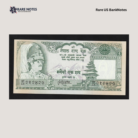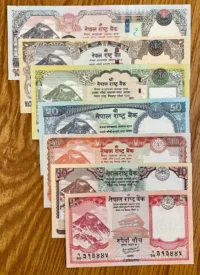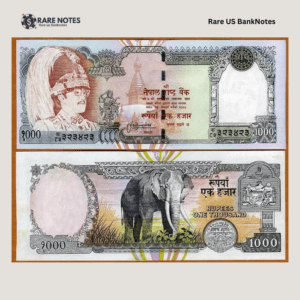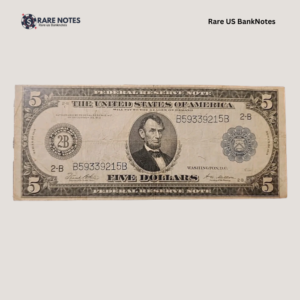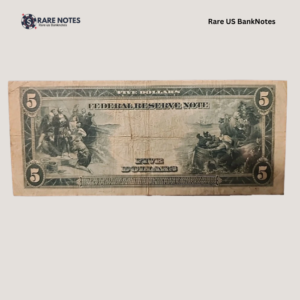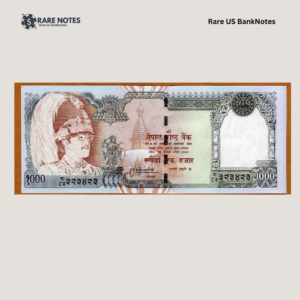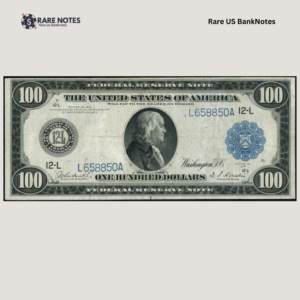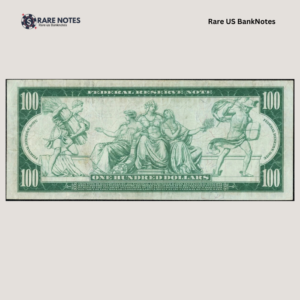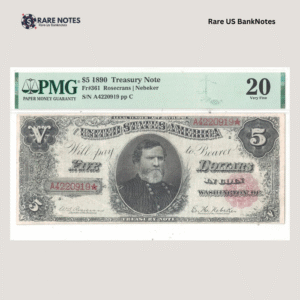Nepal 100 Rupees (1981-2001) – P-343 | UNC
🔹 Year Range: 1981-2001
🔹 Issuer: Nepal Rastra Bank
🔹 Tag phrase: Nepal 100 Rupees (1981-2001) – P-343 | UNC | King Birendra
🔹 Denomination: 100 Nepalese Rupees (Rs)
🔹 Pick Number: P-343
🔹 Condition: UNC (Uncirculated) – Crisp, full color, no folds or wear
🔹 Design Features:
Obverse: Portrait of King Birendra, Nepal’s last constitutional monarch
Reverse: Depicts Nepal’s iconic Mount Everest, showcasing the country’s natural beauty
🔹 Scarcity: Increasingly hard to find in UNC condition, making it a valuable collector’s piece
- Estimated Delivery : Up to 4 business days
- Free Shipping & Returns : On all orders over $200
Nepal 100 Rupees (1981-2001) – P-343 | UNC | King Birendra | Rare Historical Banknote
The Nepal 100 Rupees banknote (1981-2001) – P-343 is a rare and highly sought-after banknote, featuring King Birendra, one of Nepal’s most influential monarchs. Issued by the Nepal Rastra Bank, this banknote represents a crucial period in Nepalese history, spanning from 1981 to 2001, during the rule of King Birendra.
This UNC (Uncirculated) note is in pristine condition, making it a valuable collectible for numismatists and investors alike. With historical significance, intricate design elements, and increasing scarcity, this banknote is a must-have for collectors of Nepalese currency and rare world banknotes.
Historical Significance of the Nepal 100 Rupees Banknote (P-343)
This 100 Rupees banknote was issued during the reign of King Birendra Bir Bikram Shah, who ruled Nepal from 1972 until his tragic assassination in 2001. His leadership marked a crucial transition in Nepalese history, including the shift from an absolute monarchy to a constitutional monarchy in 1990. This period saw economic growth, modernization, and significant political changes, all of which are reflected in the currency issued during his reign.
The 1981-2001 series of the Nepal 100 Rupees banknote (P-343) was in circulation for two decades, witnessing major political events, including Nepal’s transition towards democracy and growing international recognition. However, following King Birendra’s assassination in the 2001 Nepalese Royal Massacre, Nepalese currency featuring his portrait became highly collectible and historically significant.
With Nepal’s monarchy officially abolished in 2008, banknotes featuring King Birendra are no longer in circulation, increasing their rarity and desirability in the numismatic market.
Design and Features of the Nepal 100 Rupees Banknote (P-343)
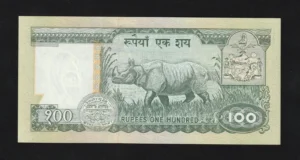
Obverse (Front Design)
- Portrait of King Birendra: A detailed engraving of King Birendra, wearing a traditional Nepalese royal outfit, symbolizing his leadership and legacy.
- Denomination in Nepali script: The note prominently displays “100 Rupees“ in Devanagari script, reflecting Nepal’s official language.
- Security Features: Includes watermarks, security threads, and microtext printing, making it a secure banknote for its time.
- Official Seal of Nepal Rastra Bank: The note features the seal of Nepal’s central bank, ensuring authenticity.
Reverse (Back Design)
- Illustration of Mount Everest: The majestic Mount Everest, Nepal’s most iconic natural wonder, is prominently featured.
- Traditional Nepalese Artwork: The note incorporates intricate traditional patterns and cultural motifs, adding to its artistic appeal.
- Denomination in Multiple Locations: The value of 100 Rupees is displayed in various positions for clarity and authenticity.
Why the Nepal 100 Rupees (P-343) is a Valuable Collectible
1. UNC Condition – Rare and Well-Preserved
- This note is in Uncirculated (UNC) condition, meaning it has never been used in transactions and retains its original crispness, vibrant colors, and sharp details.
- Finding a well-preserved Nepal 100 Rupees (P-343) banknote from this era is incredibly rare, as most circulated notes show signs of wear.
2. Historical Significance – King Birendra Era
- This note represents a significant period in Nepalese history, spanning two decades of King Birendra’s reign.
- It was issued before the 2001 Nepalese Royal Massacre, making it a reminder of Nepal’s last full monarchical era.
- Following the abolition of the monarchy in 2008, banknotes featuring King Birendra became highly collectible and historically valuable.
3. Increasing Numismatic Demand
- Nepalese banknotes from the late 20th century are becoming highly sought after by both domestic and international collectors.
- With limited surviving UNC specimens, this note is expected to appreciate in value over time.
4. Beautiful and Iconic Design
- The detailed portrait of King Birendra and the illustration of Mount Everest make this banknote visually striking.
- The combination of royal, natural, and cultural elements makes it one of Nepal’s most beautifully designed banknotes.
5. Investment Potential
- As interest in Nepalese historical banknotes grows, high-grade notes like this one have strong investment potential.
- The UNC condition, long circulation period, and historical relevance make it a rare and valuable addition to any serious collection.
How to Preserve and Display Your UNC Nepal 100 Rupees (P-343) Banknote
To maintain the value and condition of this rare UNC banknote, follow these best practices:
✔ Store in a protective sleeve (PMG or PCGS-certified) to prevent damage.
✔ Avoid direct exposure to sunlight to prevent color fading.
✔ Handle with clean, dry hands or gloves to avoid oil transfer.
✔ Keep in a cool, dry environment to prevent deterioration due to humidity.
✔ Consider professional grading and certification to further authenticate and enhance its market value.
Conclusion
The Nepal 100 Rupees banknote (1981-2001) – P-343, featuring King Birendra, is a rare and historically significant collectible. With its pristine UNC condition, beautiful design, and deep historical value, this note is an essential addition to any serious numismatic collection.
As Nepalese currency featuring King Birendra becomes harder to find, this note is a valuable asset for collectors and investors alike. With its stunning Mount Everest imagery, cultural significance, and rarity, this banknote is expected to appreciate in value over time.
Secure this rare and iconic piece of Nepalese history today before it becomes even harder to find!




